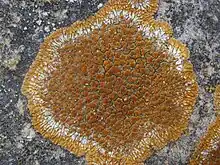Variospora flavescens
Variospora flavescens is a species of saxicolous (rock-dwelling), crustose lichen in the family Teloschistaceae.[2] It is a common, widely distributed species and has been recorded in Africa, Asia, Europe, and Macaronesia.
| Variospora flavescens | |
|---|---|
 | |
| Scientific classification | |
| Domain: | Eukaryota |
| Kingdom: | Fungi |
| Division: | Ascomycota |
| Class: | Lecanoromycetes |
| Order: | Teloschistales |
| Family: | Teloschistaceae |
| Genus: | Variospora |
| Species: | V. flavescens |
| Binomial name | |
| Variospora flavescens (Huds.) Arup, Frödén & Søchting (2013) | |
| Synonyms[1] | |
| |
Taxonomy
The species was first scientifically described by botanist William Hudson in 1762.[3] He placed it in the eponymously named genus Lichen, as was the standard practice in those times, following the example of Carl Linnaeus in his influential 1753 work Species Plantarum. In its long taxonomic history, the species has acquired an extensive list of synonyms.[1] For example, in early Italian literature, it was frequently referred to as Caloplaca murorum.[4] Jack Laundon placed the taxon in the genus Caloplaca in 1984,[5] and it was known by this binomial until 2013, when Ulf Arup, Patrik Frödén, and Ulrik Søchting transferred it to the newly circumscribed genus Variospora.[6]
Description
Variospora flavescens features a placodioid thallus, which forms large, evenly distributed, circular patches measuring 10 cm (4 in) or more in diameter. The lobes of the thallus are closely appressed, with rounded or irregular shapes. Their surface has a matte texture, varying in colour from pale to deep orange.[7]
The lobe-ends of this lichen species are not widened but are rounded and convex. They can sometimes appear faintly pruinose, meaning they have a white, waxy, powdery coating. The lobes, which are pleated and sometimes overlapping, are situated close to each other. The centre of the thallus has a closely areolate, uneven texture, composed of occasionally contorted and congested lobes. These central lobes are white and non-pigmented but are spotted with orange apothecia. These apothecia (cup-shaped fruiting bodies) reach up to 1.5 mm in diameter. They are primarily located at the centre of the thallus and are typically abundant and crowded. When young, they are flat but become convex as they age. The thalline margin, or the border of the apothecia, is the same colour as the disc initially but becomes excluded over time. The disc varies in colour from orange to orange-brown.[7]
The paraphyses (sterile fungal filaments) are slender and range from straight to flexuose, without noticeable swelling at the ends. The lemon-shaped ascospores measure 12–15 by 8–10 μm, and are swollen at the septum. The septum's breadth varies, reaching up to 5 μm wide.[7]
Habitat and distribution
Variospora flavescens is a saxicolous lichen that grows on calcareous stone, including limestone, mortar, and cement. Rarely it has been found growing on bark, although those cases are typically limited to locations near dusty lime quarries. It is widely distributed, having been recorded in Africa, Asia, Europe, and Macaronesia. In the United Kingdom, although quite common, it is not found in air-polluted areas such as industrial regions in Northern England, nor in the Scottish Lowlands.[7]
References
- "Synonymy. Current Name: Variospora flavescens (Huds.) Arup, Frödén & Søchting, Nordic Jl Bot. 31(1): 76 (2013)". Species Fungorum. Retrieved 19 June 2023.
- "Variospora flavescens (Huds.) Arup, Frödén & Søchting". Catalogue of Life. Species 2000: Leiden, the Netherlands. Retrieved 19 June 2023.
- Hudson, W. (1762). Flora anglica (in Latin). London: impensis auctoris. p. 445.
- Fiorentino, Jennifer (2017). "A Revised Appraisal of Scientific Names Used in the 1915 List of Lichens of the Maltese Islands by S. Sommier and A. Caruana Gatto". Xjenza Online (2): 137–147. doi:10.7423/XJENZA.2017.2.06.
- Laundon, J.R. (1984). "Studies in the nomenclature of British Lichens I". The Lichenologist. 16 (1): 53–57. doi:10.1017/s0024282984000086. S2CID 250348099.
- Arup, U.; Søchting, U.; Frödén, P. (2013). "A new taxonomy of the family Teloschistaceae". Nordic Journal of Botany. 31 (1): 16–83 [75]. doi:10.1111/j.1756-1051.2013.00062.x.
- Fletcher, A.; Laundon, J.R. (2009). "Caloplaca Th. Fr. (1860)". In Smith, C.W.; Aptroot, A.; Coppins, B.J.; Fletcher, F.; Gilbert, O.L.; James, P.W.; Wolselely, P.A. (eds.). The Lichens of Great Britain and Ireland (2nd ed.). London: The Natural History Museum. p. 262. ISBN 978-0-9540418-8-5.